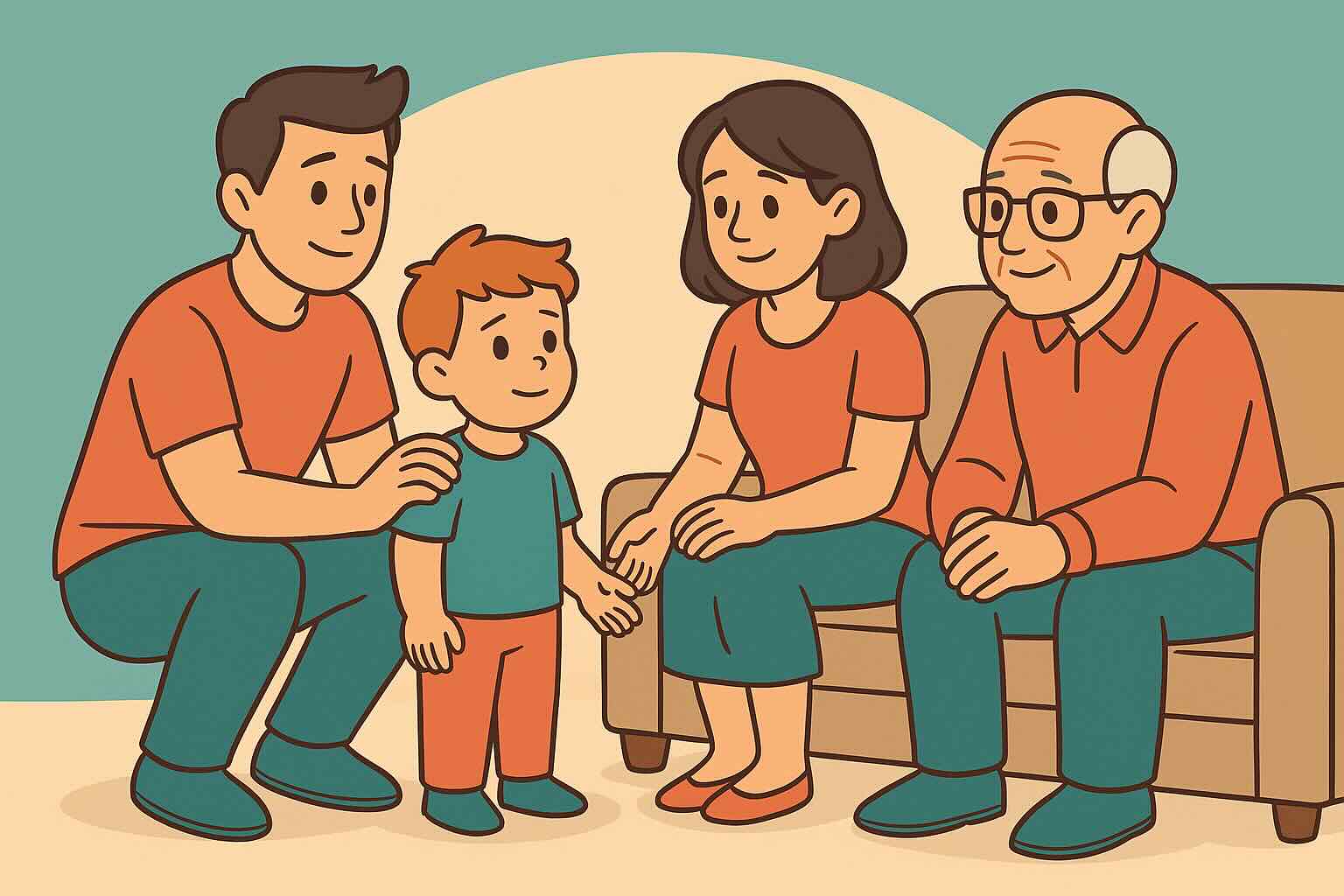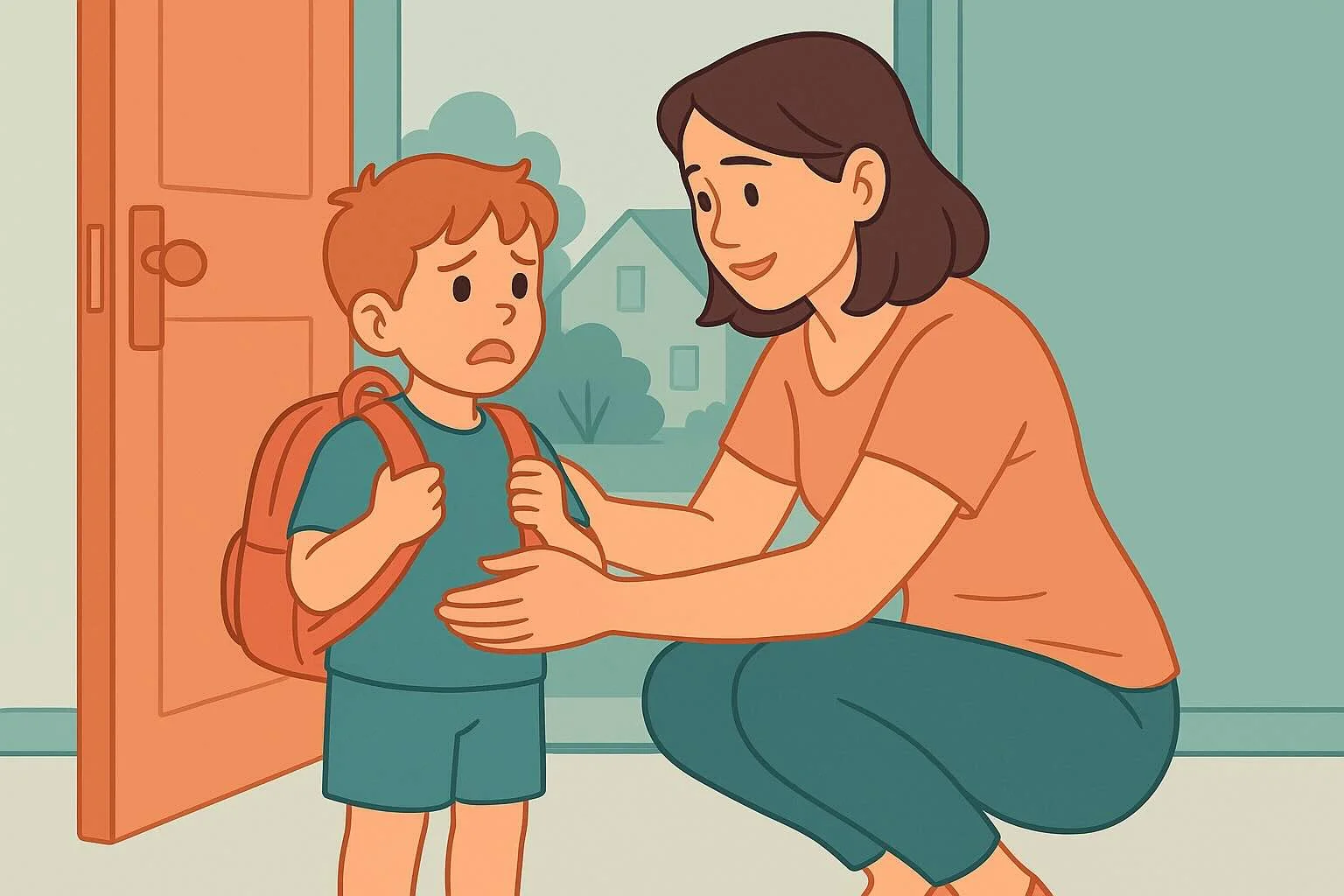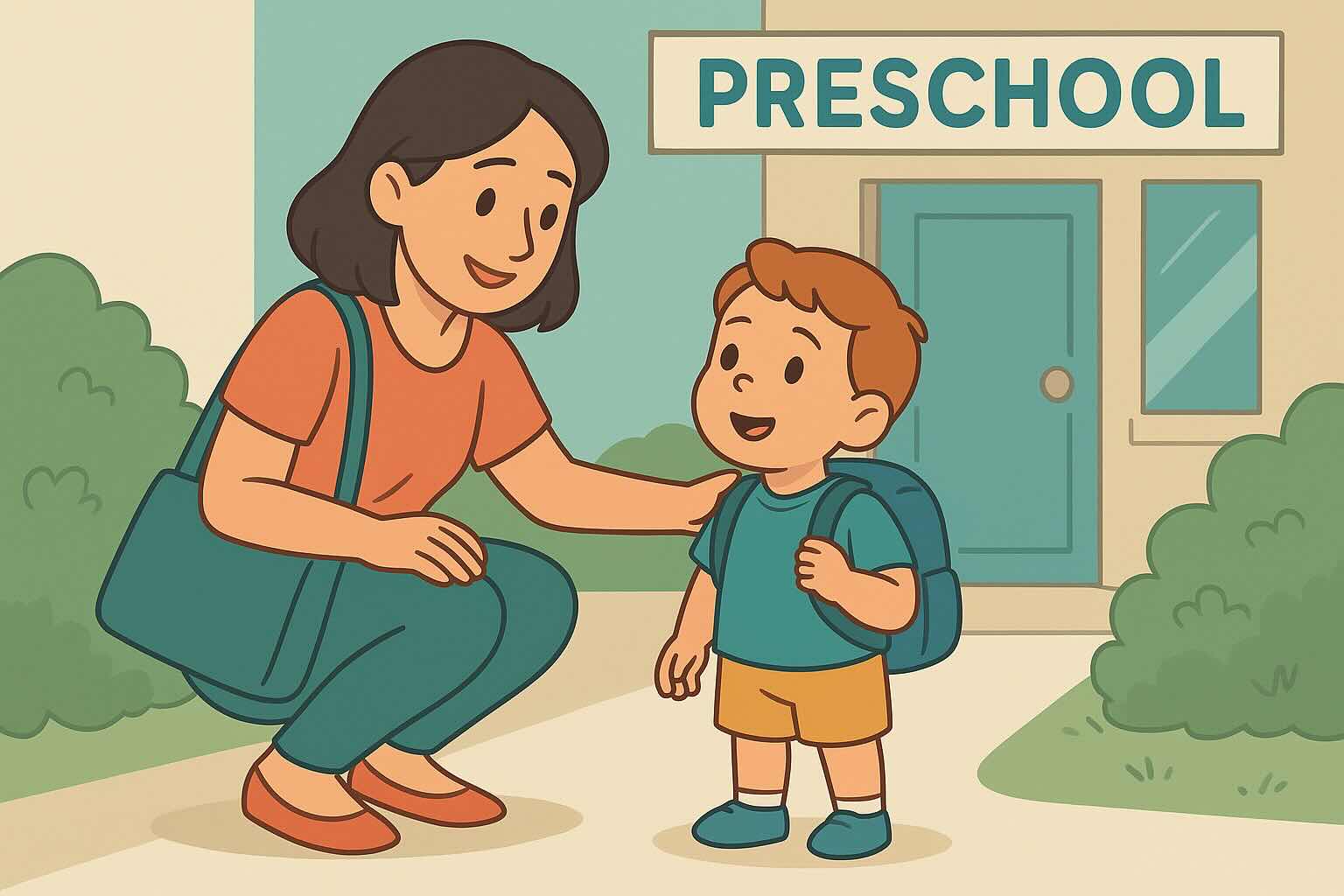Visiting Extended Family: 10 Strategies That Prevent Holiday Meltdowns


Family visits can be magical opportunities for connection and tradition-building—or they can feel like survival challenges for both parents and children. Research shows that 80% of families report increased behavioral challenges during extended family visits, but families who prepare strategically experience 50% fewer conflicts and significantly more enjoyable gatherings.
This comprehensive guide provides evidence-based strategies from family psychology research and social development experts. You'll learn how to transform potentially stressful family visits into positive experiences that build relationships and create lasting memories.
For related challenges, also check out our moving with children guide, routine changes strategies, starting school preparation, and new sibling transitions for other major family transitions.
What You'll Learn in This Guide
- The Psychology of Family Visit Stress - Why children struggle with extended family gatherings and how to support them
- Pre-Visit Preparation Strategies - Step-by-step preparation for successful family interactions
- Age-Specific Approaches - Different techniques for 3-year-olds vs. 7-year-olds during family visits
- Managing Common Challenges - Solutions for shyness, overstimulation, behavioral regression, and family conflicts
- Holiday and Special Occasion Strategies - Navigating gift-giving, traditions, and high-expectation gatherings
- Extended Stay Survival - Techniques for multi-day visits and overnight stays
- Real Family Visit Success Stories - How other families transformed stressful gatherings into positive experiences
Estimated reading time: 12 minutes
Understanding Family Visit Stress for Children
Why Family Visits Feel Overwhelming
Multiple simultaneous challenges for children:
- Environmental disruption: New or infrequently visited spaces with different rules and expectations
- Routine disruption: Changes in sleep, meal, and activity schedules
- Social pressure: Expectations to interact with people they may not remember or feel comfortable with
- Sensory overload: Increased noise, activity, and stimulation from multiple people and conversations
- Performance anxiety: Pressure to be "good" or demonstrate skills for extended family
- Attention competition: Sharing parental attention with other family members and activities
The Neuroscience of Social Overstimulation
Children's developing nervous systems can become overwhelmed during family gatherings due to:
Normal stress responses during family visits:
- Increased clinginess and need for parental proximity
- Regression in behavior, language, or independence skills
- Emotional volatility and shortened frustration tolerance
- Physical symptoms (fatigue, appetite changes, sleep disruption)
- Hyperactivity or withdrawal from social interaction
- Testing boundaries and challenging parental authority
These responses are protective mechanisms designed to help children manage overwhelming social and environmental stimulation.
Individual Differences in Family Visit Adaptation
Naturally social children may thrive on family attention but still need downtime and routine support.
Shy or sensitive children may need extensive warm-up time and frequent breaks from social interaction.
Routine-dependent children might struggle more with schedule changes than social aspects of visits.
High-energy children may become overstimulated more quickly in busy family environments.
Consider your child's temperament when planning visit length, activities, and support strategies.
Pre-Visit Preparation: The 2-Week Success Plan
Week 2: Foundation Building and Information Gathering
Begin positive conversations about the upcoming visit:
- "In two weeks, we're going to visit [family members]. We'll have fun together as a family."
- "You'll get to see [specific relatives] and play in [location/activities]."
- "Family visits are special times when we all get together and enjoy each other."
Gather practical information:
- Review photos of family members your child will see
- Discuss the location, sleeping arrangements, and basic schedule
- Plan travel logistics and timing
- Coordinate with hosting family about meal preferences and routine needs
Address your child's questions and concerns:
- Answer questions honestly in age-appropriate terms
- Validate any worried feelings about seeing people they don't remember well
- Share positive stories about previous visits or family memories
- Explain family relationships in simple terms ("Grandma is daddy's mommy")
Week 1: Intensive Preparation and Practice
Practice social skills and family interactions:
- Role-play meeting relatives and appropriate greetings
- Practice saying "please," "thank you," and basic polite conversation
- Discuss family rules that might be different from home rules
- Practice asking for help or expressing needs to different family members
Prepare for routine disruptions:
- Discuss how schedules might be different during the visit
- Pack comfort items and familiar belongings
- Plan quiet time activities for overstimulation breaks
- Adjust home routine slightly to prepare for visit schedule if needed
Final logistics and emotional preparation:
- Confirm travel plans and pack familiar items
- Create a simple visual schedule of visit activities if helpful
- Discuss gift-giving expectations if applicable
- Plan special connection time during busy visit schedule
Age-Specific Family Visit Strategies
Ages 3-4: Security Needs and Stranger Anxiety
Developmental considerations:
- Limited memory of family members seen infrequently
- High need for parental proximity and familiar objects
- Difficulty with social expectations and performance pressure
- Strong attachment to routine and predictable environments
Effective preparation strategies:
- Use photos to familiarize with family members they'll see
- Pack extra comfort items (stuffed animals, blankets, special cups)
- Plan shorter interaction periods with built-in breaks
- Stay physically close during initial interactions to provide security
- Maintain key routine elements (nap time, bedtime rituals, familiar foods)
Common challenges:
- Refusing to interact with relatives or hiding behind parents
- Increased tantrums and emotional outbursts
- Sleep disruption and difficulty settling in unfamiliar environments
- Regression in toilet training or independence skills
Ages 4-5: Social Awareness and People-Pleasing
Developmental readiness:
- Better memory of family relationships and previous visits
- Growing interest in pleasing adults and being "good"
- Increased social awareness but limited social stamina
- Desire to be helpful and participate in family activities
Preparation focuses:
- Explain family relationships and why visits are important
- Discuss appropriate ways to interact with different family members
- Practice gift-giving scenarios and social expectations
- Plan special jobs or ways they can help during the visit
- Prepare for overstimulation with designated quiet activities
Common concerns:
- Worry about making mistakes or disappointing family members
- Excitement followed by overstimulation and emotional crashes
- Confusion about different family rules and expectations
- Desire for individual attention in group settings
Ages 5-7: Social Competence and Family Identity
Advanced capabilities:
- Understanding of family relationships and visit purposes
- Ability to engage in longer social interactions appropriately
- Interest in family stories, traditions, and history
- Capability to help with visit planning and problem-solving
Collaboration strategies:
- Include them in visit planning and activity discussions
- Explain family traditions and their role in continuing them
- Discuss appropriate behavior expectations for different settings
- Plan meaningful ways they can contribute to family gatherings
- Help them understand and navigate different family personalities
Unique considerations:
- Awareness of family dynamics and potential conflicts
- Comparison between their family and extended family practices
- Desire to maintain friendships and activities at home
- Understanding of visit duration and its impact on regular schedule
Managing Common Family Visit Challenges
Shyness and Social Withdrawal
The WARM Approach:
W - Wait and Allow Warm-Up Time Don't rush social interactions or force immediate engagement with relatives.
- "It's okay to feel shy when you see people you don't visit very often."
- "You can stay close to me until you feel ready to say hello."
- "Take your time—there's no hurry to talk or play with everyone right away."
A - Acknowledge Feelings and Validate Experience Normalize your child's need for time to feel comfortable.
- "Meeting lots of people at once can feel overwhelming."
- "It makes sense to feel nervous around people you don't see very often."
- "Some people need more time to feel comfortable, and that's perfectly normal."
R - Remain Close and Provide Security Stay physically and emotionally available during initial interactions.
- Position yourself where your child can see and reach you easily
- Offer hand-holding or physical comfort during greetings
- Don't disappear into adult conversations immediately upon arrival
- Create opportunities for one-on-one interactions rather than group pressure
M - Make Gentle Encouragement (Without Pressure) Encourage participation without forcing or bribing.
- "Would you like to show Grandma your new book?"
- "Cousin Sarah is playing with puzzles—that looks fun."
- "When you're ready, I bet Uncle Mike would love to hear about your soccer team."
Overstimulation and Sensory Overload
Recognizing overstimulation signals:
- Increased emotional volatility or sudden meltdowns
- Hyperactivity or restless behavior
- Withdrawal from activities or conversations
- Physical symptoms (complaints of tiredness, headaches, stomachaches)
- Difficulty following directions or increased defiance
Proactive overstimulation management:
- Schedule regular quiet breaks away from group activities
- Create a designated calm space with familiar items
- Limit duration of large group activities
- Use noise-canceling headphones or quiet music if needed
- Maintain predictable meal and sleep timing when possible
Crisis intervention for overwhelmed children:
- Remove child from stimulating environment immediately
- Find a quiet, calm space for emotional regulation
- Offer comfort without trying to fix or explain the situation
- Allow time for nervous system to settle before returning to activities
- Don't apologize excessively to family members—prioritize your child's needs
Behavioral Regression and Testing Boundaries
Understanding visit-related regression: Temporary regression is a normal stress response, not poor parenting or deliberate misbehavior.
Common regression behaviors during visits:
- Loss of independence in dressing, eating, or toileting
- Baby talk or clingy behavior
- Increased need for help with routine tasks
- Testing rules and boundaries more frequently
- Sleep disruption and bedtime resistance
Supportive responses to regression:
- Provide extra help without shame or pressure to "act your age"
- Maintain consistent boundaries while offering additional emotional support
- Recognize regression as temporary stress response
- Focus on comfort and connection rather than correction
- Trust that normal behavior will return after visit stress decreases
Family Member Conflicts and Different Parenting Styles
When family members question your parenting:
- Stay calm and confident in your decisions
- Explain your approach briefly without over-justifying
- Redirect focus to your child's specific needs: "This helps [child's name] feel secure"
- Set boundaries about unsolicited advice: "We've found this works best for our family"
Managing different house rules:
- Discuss key differences with your child beforehand
- Maintain your family's non-negotiable safety and respect rules
- Allow flexibility on minor issues (bedtime, screen time, treats)
- Communicate privately with hosting family about important boundaries
Sample scripts for common conflicts:
- "We appreciate your concern, and this approach works well for [child's name]."
- "Every family does things differently—this is what helps our child feel secure."
- "I understand your suggestion, and we'll stick with our usual approach for consistency."
Holiday and Special Occasion Strategies
Gift-Giving and Expectation Management
Preparing children for gift scenarios:
- Practice saying "thank you" regardless of personal feelings about gifts
- Explain that gifts are expressions of love, even if they're not perfect matches for interests
- Discuss what to do if they receive duplicate or unwanted gifts
- Prepare for the possibility of not receiving expected gifts
Managing gift-giving pressure:
- "Gifts are about showing love, not about getting things we want."
- "It's polite to say thank you even if a gift isn't exactly what you hoped for."
- "Sometimes people give gifts that are better for when you're older."
- "The most important part of family visits is spending time together."
Family Traditions and Participation Expectations
Helping children understand and participate in traditions:
- Explain the history and meaning behind family traditions in age-appropriate terms
- Describe their role in continuing family traditions
- Allow some choice in level of participation when possible
- Create new traditions that include children's interests and capabilities
When children resist traditional activities:
- Validate their feelings while explaining importance to family
- Offer modified ways to participate that match their developmental level
- Focus on connection rather than perfect performance
- Allow breaks from traditional activities when overstimulation occurs
Managing High-Expectation Events
Strategies for formal dinners, religious services, or special ceremonies:
- Prepare children with specific behavior expectations
- Plan entertainment or quiet activities for long events
- Allow for bathroom breaks and movement opportunities
- Have exit strategy ready if child becomes overwhelmed
Extended Stay Survival Strategies
Multi-Day Visit Planning
Essential elements for extended stays:
- Maintain consistent sleep routines even in unfamiliar environments
- Pack enough familiar items to create sense of home
- Plan daily quiet time or alone time for emotional regulation
- Coordinate with hosting family about daily schedule and expectations
Balancing family time with individual needs:
- Schedule one-on-one time with your child daily
- Plan activities that match your child's interests and energy level
- Allow for flexibility in participation—not every activity needs to include everyone
- Respect your child's social stamina and need for breaks
Overnight Stay Considerations
Sleep environment preparation:
- Bring familiar bedding, stuffed animals, and comfort items
- Maintain bedtime routine as closely as possible
- Prepare for potential sleep disruption and plan accordingly
- Consider room-sharing with parents if child is anxious about unfamiliar space
Managing homesickness:
- Validate feelings of missing home and familiar routines
- Allow phone calls to friends or other family members if helpful
- Plan special activities that create positive memories
- Reassure about return home timeline without making visit feel burdensome
Real-Life Family Visit Success Stories
The Patterson Family: Conquering Holiday Overwhelm
"Christmas at my in-laws' house used to be a nightmare with our 4-year-old daughter. Thirty people, loud conversations, gift chaos, and constant overstimulation led to epic meltdowns every year. Last year, we implemented a survival plan: arrived the day before to help her adjust gradually, created a quiet room upstairs with her comfort items, planned 30-minute breaks every 2 hours, and gave her specific jobs to feel important (handing out gifts, helping set the table). We also talked to family beforehand about giving her space to warm up. The difference was incredible—she actually enjoyed herself and still talks about 'helping Christmas happen.'"
The Kim Family: Managing Multi-Generational Expectations
"Visiting my traditional Korean grandmother with our 6-year-old son always created tension. She expected him to sit quietly, eat everything served, and show perfect respect, while he needed movement and familiar foods. We started preparing him with photos and stories about Korean culture, packed some of his favorite snacks, and practiced polite greetings in Korean. Most importantly, I had honest conversations with my grandmother about his developmental needs. She was more understanding than I expected, and we found ways to honor both traditions and his needs. Now he's proud of his Korean heritage and excited to visit."
The Rodriguez Family: Transforming Shy Child's Family Interactions
"Our 5-year-old daughter Maria was painfully shy during family visits, hiding behind us and refusing to talk to relatives. Family members started taking it personally and making comments about her being 'rude.' We changed our approach: stopped forcing interactions, let her observe from our laps initially, brought activities she could do near other people, and asked family to let her initiate contact. We also practiced social skills at home through role-play. It took several visits, but now she confidently talks to relatives and even initiates games with her cousins. The key was removing pressure and letting her develop comfort at her own pace."
Your 10-Day Family Visit Success Plan
Days 1-3: Initial Preparation and Assessment
- Assess your child's current stress level and any concerns about the visit
- Begin positive conversations about family members they'll see
- Review photos and share stories about previous positive family experiences
- Start gathering information about visit logistics and activities
Days 4-6: Skill Building and Emotional Preparation
- Practice social skills like greetings, polite conversation, and saying thank you
- Discuss family rules that might be different from home
- Address any specific fears or concerns your child expresses
- Begin packing comfort items and familiar belongings
Days 7-10: Final Preparation and Confidence Building
- Finalize travel and visit logistics with hosting family
- Create simple visual schedule of visit activities if helpful
- Practice overstimulation management strategies and quiet time activities
- Focus on excitement and positive anticipation while acknowledging any worries
During Visit: Implementation and Support
- Maintain focus on your child's needs while respecting family dynamics
- Implement planned strategies for shyness, overstimulation, and regression
- Stay flexible and adjust plans based on your child's real-time needs
- Prioritize connection and positive memories over perfect behavior
Post-Visit: Processing and Learning
- Discuss positive memories and experiences from the visit
- Address any difficult moments with understanding and problem-solving
- Plan improvements for future visits based on what you learned
- Maintain connection with family members through photos or video calls
Building Long-Term Family Relationship Success
Teaching Family Values and Connection
Help children understand that family relationships are lifelong investments that require patience, understanding, and effort:
- "Families love each other even when we don't see each other very often."
- "Getting to know family members takes time, and that's normal."
- "Everyone in our family is different, and we can learn from each other."
Creating Positive Family Visit Traditions
Develop visit traditions that work for your child:
- Special activities that happen only during family visits
- Traditions that highlight your child's growth and development
- Ways for your child to contribute meaningfully to family gatherings
- Quiet traditions that provide regulation during busy times
Preparing for Future Independence
Build social skills and family relationship foundation:
- Gradually increase your child's independence during family interactions
- Teach them to advocate for their own needs appropriately
- Develop their understanding of family history and connections
- Create positive associations with family relationships and gatherings
Key Takeaways: Your Family Visit Success Guide
- ✅ Family visit stress affects 80% of families but strategic preparation reduces conflicts by 50%
- ✅ Behavioral regression during visits is normal and temporary stress response
- ✅ Overstimulation management is crucial for positive family visit experiences
- ✅ Respecting your child's social pace builds confidence rather than forcing interactions
- ✅ Maintaining key routines provides stability during environmental and social changes
- ✅ Family member cooperation improves outcomes when children's needs are understood
- ✅ Visit length should match child's developmental capacity for social interaction
- ✅ Building positive associations takes time and multiple successful experiences
- ✅ Family relationships benefit from patience and understanding during childhood development
Remember: Family visits are opportunities to build lifelong relationships and create positive memories. With preparation, realistic expectations, and focus on your child's developmental needs, these gatherings can become sources of joy rather than stress.
This article is based on family psychology research and social development studies. Individual experiences vary significantly based on child temperament, family dynamics, and visit circumstances. Always prioritize your child's wellbeing and developmental needs when planning family visits and social interactions.
24/7 AI Parenting Assistant
Get instant, personalized advice with expert-curated parenting knowledge. Chat with your AI coach anytime, anywhere.

Routine Transition Planner
4-week method for implementing routine changes successfully with gradual strategies and resistance management techniques.
Frequently Asked Questions
Need personalized support?
RootWise's AI coach can provide tailored strategies for your specific situation, available 24/7 when you need it most.
Learn More About AI Coaching →



